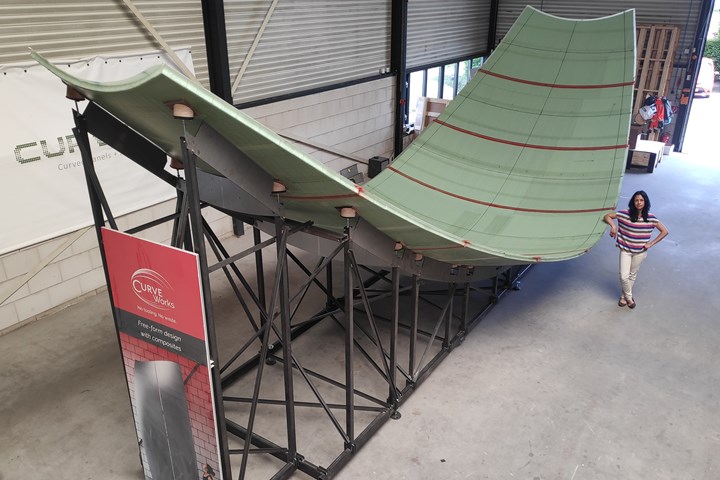Curve Works reaches milestone for modular builds of composite shell structures
Approach reduces cost by 40%, lead-time by 50% and material use by >70% compared to manufacturing in large, one-off mold.

Curve Works builds large, double-curved composite structures using panel assembly approach and adaptive mold technology. Photo Credit: Curve Works
In its mission to manufacture large composite structures without the waste from tooling, Curve Works (Alphen aan den Rijn, Netherlands) has been pushing forward composite panel assembly forward for increased sustainability. As the name suggests, the panel assembly approach assembles the structure from panels rather than using a large mold. The goal is to reduce the cost, lead-time and waste of one-off molds and molding tools.
To demonstrate this approach, Curve Works has manufactured a series of unique, doubly-curved composite sandwich panels using its automated adaptive mold. The panels, sized up to 4 x 1.6 meters, were assembled on a metal-frame jig and bonded together using Curve Works’ proprietary technology. The result is an airtight structure 10 meters long, 4 meters wide and 3 meters tall.
curved structure manufacturing steps
Materials were also chosen for sustainability, including Kerdyn Green PET structural foam and Ampro BIO epoxy resin, both supplied by Gurit (Wattwil, Switzerland).
The whole process from panel production to structural assembly took only 14 working days. “It’s a major milestone for us to demonstrate such cost-effective and sustainable, modular building,” says Tahira Ahmed, co-founder of Curve Works. “Compared to manufacturing using a large mold, our figures show that we can reduce cost by 40%, lead-time by 50% and, importantly, material use by at least 70%.”
“The panel assembly approach, together with adaptive mold technology, allows Curve Works to be very flexible in both shape and size of the final parts,” says Ahmed. “We have a production technology here that allows us to go as large as the customer needs without the costs and tooling waste increasing exponentially as well.”
Related Content
-
Carbon fiber satellite arm reduces weight, simplifies assembly onto naval vessels
Satcom developer EM Solutions partnered with ACS Australia to replace an aluminum arm design with a 65% lighter, one-piece, corrosion-resistant carbon fiber/epoxy alternative.
-
Low-cost, efficient CFRP anisogrid lattice structures
CIRA uses patented parallel winding, dry fiber, silicone tooling and resin infusion to cut labor for lightweight, heavily loaded space applications.
-
Ceramic matrix composites: Faster, cheaper, higher temperature
New players proliferate, increasing CMC materials and manufacturing capacity, novel processes and automation to meet demand for higher part volumes and performance.





